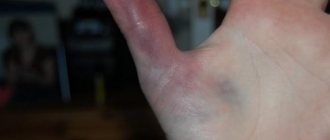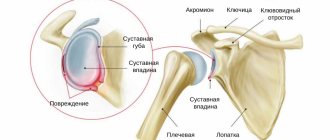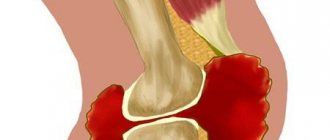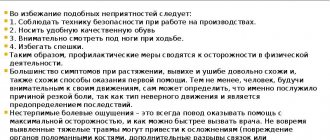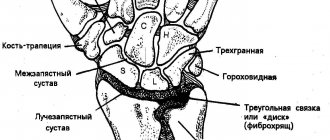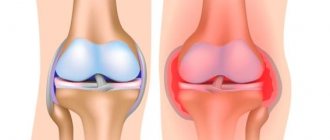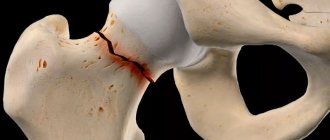Diagnosis of this injury
If you experience a dislocation, you must immediately consult a traumatologist. Diagnostics involves a preliminary examination of the victim and the appointment of a set of studies, namely:
- radiography (based on an x-ray of the joint, the degree of its damage, the likelihood of bone displacement, the presence of damage to soft tissues, muscles or nerve endings are determined)
- arteriogram (X-ray examination of blood vessels or ultrasound)
- consultation with a neurologist (if the hand is immobile)
- pulsometry
Elbow dislocation concept
An elbow dislocation is a violation of the anatomical articulation of the three bones of the elbow joint (humerus, ulna and radius), accompanied by rupture of the capsule, damage to the ligaments, and hemorrhage into nearby tissues.
The capsular-ligamentous apparatus of the elbow joint is a rather complex, unique and vulnerable anatomical unit, which creates the preconditions for the occurrence of various types of damage and dislocations.
Elbow dislocation is the second most common injury after shoulder dislocation.
Rehabilitation after elbow dislocation
After the treatment, a long period of restoration of the elbow’s full functionality begins. The following methods are used for this:
- Therapeutic gymnastics (therapeutic exercises) – a set of physical exercises to restore joint mobility
- Physiotherapy (various types of warming, etc.)
- Swimming (prescribed four weeks after removing the plaster cast, significantly speeds up the development of joints)
- Massage (to increase blood flow to the damaged joint, the massage option is selected by the doctor)
- Compresses, ointments (to supply joint tissues with necessary nutrients)
- Vitamin therapy
During rehabilitation, it is necessary to wear support bandages.
An unfavorable consequence of complicated dislocations may be stiffness or contracture of the joints (limited mobility in the joint). Therefore, the recovery period may take longer. In general, the prognosis for recovery is favorable.
First aid, treatment and recovery
First aid is provided by a traumatologist. The doctor conducts a primary differential diagnosis and reduces the dislocation. Then, as a treatment for dislocation of the elbow joint, a bandage is applied. The limb is fixed in a bent state and suspended from a bandage. For the next 10 to 14 days, it will be recommended to completely avoid any physical activity. Mobility can provoke re-dislocation, so it is better to follow this doctor’s recommendation.
Massage after a dislocation of the elbow joint in combination with physiotherapy can be started after 5 - 7 days. This will reduce the risk of developing contracture and prevent the risk of disruption of microcirculation of blood and lymphatic fluid in the area of injury.
How long it takes to recover from a dislocated elbow joint depends on the complexity of the injury and the degree of damage to surrounding tissues. If the joint capsule is ruptured, recovery from elbow dislocation can take up to 3-4 months. If the injury did not damage the ligaments and tendons, and the joint capsule retained its integrity, then two weeks is enough to stop the acute manifestations of the pathology.
Then, the recovery of a dislocated elbow joint consists of rehabilitation according to an individually developed plan. Here, again, everything depends on the severity of the complications that have developed. If a contracture has formed during the exclusion of mobility, then it will take more time to develop the arm. And when the ligamentous and tendon apparatus is sprained, time should be allowed to restore the elasticity and performance of these tissues.
Treatment of forearm dislocation and elbow instability
Contracture (permanent limitation of mobility) of the elbow joint develops quite quickly compared to other large joints. Therefore, early mobilization after forearm dislocation is critical to maintaining elbow mobility. In this case, constant monitoring by a doctor is very important.
Treatment of dislocations
Treatment of dislocations: reduction and rehabilitation
The first step in treating a dislocated forearm is reduction.
It is carried out in a hospital or emergency room after an x-ray examination and with proper anesthesia. To clarify the nature of ligament damage, magnetic resonance imaging (MRI) will be performed. In complex fracture-dislocations, computed tomography (CT) may be required to clarify the nature of the injury.
Minor ligament injuries can be treated conservatively, often with the use of orthoses to maintain an optimal orthotic regimen.
For massive injuries, surgical treatment may be required. During surgery, the ligaments are sutured or replaced with donor tendons.
Treatment of instability
Treatment of Elbow Instability
For minor instability, the basis of treatment is physical therapy. In severe cases, surgical stabilization of the joint is required. Subsequently, the patient must also train the muscles and follow an orthopedic regimen.
Types of dislocations
Dislocations differ according to the following characteristics:
- Complete or incomplete dislocation (with incomplete dislocation, the articular surface is displaced, but does not extend beyond the torn capsular-ligamentous apparatus);
- Dislocation of one or two forearm bones;
- Fracture-dislocations (dislocation can be combined with a bone fracture).
Depending on the time that has passed since the injury, the dislocation may be:
- fresh – up to 3 days;
- stale – up to 2 weeks;
- outdated – more than 2 weeks.
If a dislocation is repeated 3 or more times in one joint without significant physical impact, then it is called habitual. It is caused by the anatomical features of the structure of the joint, congenital or post-traumatic.
Features of a dislocated elbow
The nature of the dislocation is determined by the mechanism of damage to the joint. During sports training, falls on a straight arm often occur, resulting in a posterolateral dislocation. If the fall occurs on a bent arm, an anterior dislocation may occur.
When falling onto an extended joint with rotation, the force acting along the axis pushes the bones of the forearm apart and the humerus is wedged between them. The result of such an injury will be a divergent dislocation. This is a fairly rare case that requires special skill and practical experience of the surgeon for high-quality reduction of the dislocation.
Diagnosis of dislocations
Diagnosis of an elbow dislocation is not difficult for a qualified traumatologist - a highly specialized specialist in the pathology of the elbow joint in our clinic. The patient usually holds his arm in an unnatural position, supporting it with his healthy arm. The injured joint looks deformed and swollen. It will be extremely painful to try to make any movements with your hand. Posterior dislocation is characterized by retraction of the skin over the olecranon, while anterior dislocation is characterized by the absence of the apex of the olecranon.
To clarify the position of the bones, the doctor will gently palpate the injured joint and feel the condition of the muscles and tendons. To exclude possible bone fractures, an x-ray of the injured joint is prescribed in two projections.
X-ray examination of a habitual elbow dislocation may show ossification along the collateral ligaments, a flatter appearance of the lunate, or malunited comminuted fractures of the elbow bones.
Symptoms and signs: Pain and swelling
When a joint is dislocated, it takes on an unnatural configuration and its mobility is severely limited. Then pronounced swelling appears. An attempt to move is accompanied by severe pain. Often the pain also spreads to adjacent segments of the limb. As a result of nerve malnutrition or damage, numbness and loss of sensation below the level of the elbow joint may occur.
The most common physiotherapeutic methods:
● Electrophoresis;
● Magnetic therapy;
● Ultrasound therapy;
● Laser therapy.
Electrophoresis of medicinal substances is a type of physiotherapy, which is based on the use of direct current and medicinal substances administered with its help. The medicine breaks down into ions when in an aqueous solution. When current is passed through the solution, the drug ions begin to move, evenly penetrating the human skin, mucous membrane, intercellular fluid - this is how they penetrate and spread throughout the patient’s body.
Magnetic therapy is one of the recent innovations in the field of physical therapy. It works on the influence of an alternating magnetic field, both on the entire body as a whole and on a certain part of it. Devices equipped with computer software can carry out continuous monitoring, thanks to which the doctor can create individual programs for each patient.
Magnetotherapy relieves pain, lowers blood pressure, and triggers recovery and regenerative processes. It has a strong anti-inflammatory and decongestant agent. Magnetotherapy normalizes blood and lymphatic vessels, improving the functioning of the autonomic nervous system. This type of therapy helps normalize sleep, improves psychophysical and emotional state.
Ultrasound treatment - this therapy has a mechanical, physico-chemical and mild thermal effect on the body. Thanks to the properties of ultrasound, redox processes in tissues occur faster. Ultrasound is used in the treatment of internal diseases, diseases of the joints, and ENT organs.
Laser therapy is one of the fairly new methods of physiotherapy, which has been used for just over 30 years. The light emitted by the laser penetrates to great depths and triggers metabolism in diseased tissues, stimulating the entire body. The laser can be placed intravenously to directly affect the blood. Intravascular laser application can strengthen the immune system, increase blood transport functions, and enhance metabolism.
The use of physical therapy during recovery from injuries, as well as independently, is very beneficial for the human body. In addition to the enhancing effect of other treatment methods, physiotherapy reduces the risk of complications and reduces the recovery period, which has a beneficial effect on the body’s recovery.
By using physical therapy, you can reduce the dose of medications used in treatment during recovery from injuries , improve blood circulation, overall muscle tone, and reduce inflammation and swelling. You can develop a large and varied recovery course using physiotherapeutic methods that are worth using when recovering from injuries, as well as to improve your overall health!
Treatment of dislocations
Depending on the type of injury and the results of additional studies, a specialized trauma surgeon at our specialized medical center will determine the treatment strategy for an elbow dislocation.
The best results, according to German surgeons, are achieved when treating fresh dislocations, so we recommend that you contact the coordinators of our center as soon as possible immediately after the injury. However, our specialists guarantee a thorough examination of the condition of the joint after chronic injuries and selection of optimal treatment and rehabilitation tactics.
A fresh traumatic dislocation without a fracture is reduced under general anesthesia to ensure complete muscle relaxation. The procedure is performed by an experienced doctor with the help of an assistant. The joint is gradually straightened, without sudden movements, the surgeon holds the lower part of the humerus, and, depending on the type of dislocation, shifts the apex of the olecranon to the desired direction. Next, a splint is applied and the joint is fixed in the desired position for no more than 10-12 days.
If the dislocation is not fresh, but no more than 12-14 days have passed since the injury, you can also try to reduce it under anesthesia, but all actions should be more delicate and careful. Here, the experience and qualifications of the surgeon are of particular importance, since it is when untrained dislocations are reduced by inexperienced doctors that the neck of the humerus often breaks.
An old dislocation cannot be reduced; this situation requires only surgical intervention (open reduction), since the tissues of the joint have already partially healed and the efforts made for reduction must be significant, and this will certainly lead to a fracture of the adjacent bones.
Habitual dislocations of the elbow joint also require surgical treatment. To restore the stability of the capsular-ligamentous apparatus, German doctors use several surgical techniques:
- Deepening of the semilunar notch using bone grafting;
- Changes in the area of attachment of muscles and tendons;
- Complex plastic surgery of the joint (suture).
Each type of operation has its own indications and side effects. Our surgeons came to the conclusion that the most optimal is a combination of several types of operations and a qualified set of rehabilitation measures.
Rehabilitation
After the operation and removal of the fixing bandages, the patient is shown active development of the elbow joint under the supervision of an experienced rehabilitation trainer. It should be noted that the patient must perform all movements independently; forceful assistance can only worsen the condition of the ligamentous apparatus. Massage and other physiotherapeutic procedures that accelerate tissue healing are not prescribed, as excessive scarring of the joint tissues affected during the operation is possible.
The functions and performance of the operated elbow joint are restored in 1.5-2 months.
Our surgeons, highly specialized specialists in the pathology of the elbow joint, have performed a colossal number of successful operations to treat elbow dislocations. Thanks to modern surgical techniques, extensive experience of doctors, innovative equipment and a rehabilitation program individually developed for each case, we have helped thousands of athletes recover as quickly as possible and continue professional training without compromising their health.
